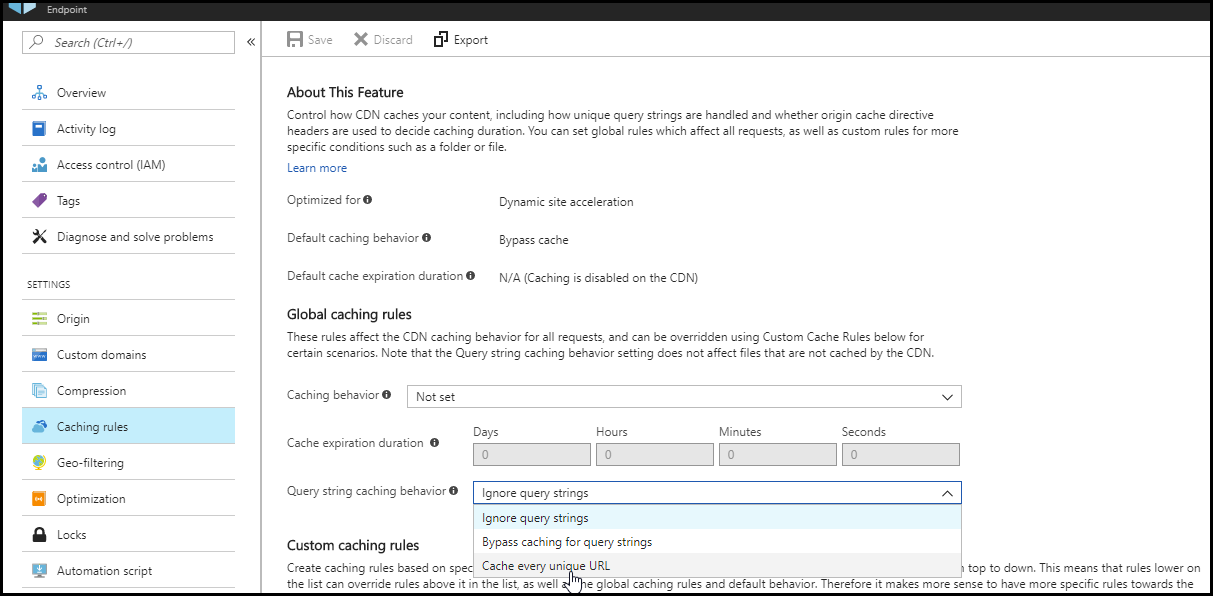Using Azure Content Delivery Network with SAS
Important
Azure CDN Standard from Microsoft (classic) will be retired on September 30, 2027. To avoid any service disruption, it's important that you migrate your Azure CDN Standard from Microsoft (classic) profiles to Azure Front Door Standard or Premium tier by September 30, 2027. For more information, see Azure CDN Standard from Microsoft (classic) retirement.
Azure CDN from Edgio was retired on January 15, 2025. For more information, see Azure CDN from Edgio retirement FAQ.
When you set up a storage account for Azure Content Delivery Network to use to cache content, by default anyone who knows the URLs for your storage containers can access the files that you've uploaded. To protect the files in your storage account, you can set the access of your storage containers from public to private. However, if you do so, no one is able to access your files.
If you want to grant limited access to private storage containers, you can use the Shared Access Signature (SAS) feature of your Azure Storage account. A SAS is a URI that grants restricted access rights to your Azure Storage resources without exposing your account key. You can provide a SAS to clients that you don't trust with your storage account key but to whom you want to delegate access to certain storage account resources. By distributing a Shared Access Signature URI to these clients, you grant them access to a resource for a specified period of time.
With a SAS, you can define various parameters of access to a blob, such as start and expiry times, permissions (read/write), and IP ranges. This article describes how to use SAS with Azure Content Delivery Network. For more information about SAS, including how to create it and its parameter options, see Using shared access signatures (SAS).
Setting up Azure Content Delivery Network to work with storage SAS
The following two options are recommended for using SAS with Azure Content Delivery Network. All options assume that you've already created a working SAS (see prerequisites).
Prerequisites
To start, create a storage account and then generate a SAS for your asset. You can generate two types of stored access signatures: a service SAS or an account SAS. For more information, see Types of shared access signatures.
After you've generated a SAS token, you can access your blob storage file by appending ?sv=<SAS token> to your URL. This URL has the following format:
https://<account name>.blob.core.windows.net/<container>/<file>?sv=<SAS token>
For example:
https://democdnstorage1.blob.core.windows.net/container1/demo.jpg?sv=2017-07-29&ss=b&srt=co&sp=r&se=2038-01-02T21:30:49Z&st=2018-01-02T13:30:49Z&spr=https&sig=QehoetQFWUEd1lhU5iOMGrHBmE727xYAbKJl5ohSiWI%3D
For more information about setting parameters, see SAS parameter considerations and Shared Access Signature parameters.
Using SAS with pass-through to blob storage from Azure Content Delivery Network
This option is the simplest and uses a single SAS token, which is passed from Azure Content Delivery Network to the origin server.
Select an endpoint, select Caching rules, then select Cache every unique URL from the Query string caching list.

After you set up SAS on your storage account, you must use the SAS token with the content delivery network endpoint and origin server URLs to access the file.
The resulting content delivery network endpoint URL has the following format:
https://<endpoint hostname>.azureedge.net/<container>/<file>?sv=<SAS token>For example:
https://demoendpoint.azureedge.net/container1/demo.jpg?sv=2017-07-29&ss=b&srt=c&sp=r&se=2027-12-19T17:35:58Z&st=2017-12-19T09:35:58Z&spr=https&sig=kquaXsAuCLXomN7R00b8CYM13UpDbAHcsRfGOW3Du1M%3DFine-tune the cache duration either by using caching rules or by adding
Cache-Controlheaders at the origin server. Because Azure Content Delivery Network treats the SAS token as a plain query string, as a best practice you should set up a caching duration that expires at or before the SAS expiration time. Otherwise, if a file is cached for a longer duration than the SAS is active, the file might be accessible from the Azure Content Delivery Network origin server after the SAS expiration time has elapsed. If this situation occurs, and you want to make your cached file inaccessible, you must perform a purge operation on the file to clear it from the cache. For information about setting the cache duration on Azure Content Delivery Network, see Control Azure Content Delivery Network caching behavior with caching rules.
SAS parameter considerations
Because SAS parameters aren't visible to Azure Content Delivery Network, Azure Content Delivery Network can't change its delivery behavior based on them. The defined parameter restrictions apply only on requests that Azure Content Delivery Network makes to the origin server, not for requests from the client to Azure Content Delivery Network. This distinction is important to consider when you set SAS parameters.
| SAS parameter name | Description |
|---|---|
| Start | The time that Azure Content Delivery Network can begin to access the blob file. Due to clock skew (when a clock signal arrives at different times for different components), choose a time 15 minutes earlier if you want the asset to be available immediately. |
| End | The time after which Azure Content Delivery Network can no longer access the blob file. Previously cached files on Azure Content Delivery Network are still accessible. To control the file expiry time, either set the appropriate expiry time on the Azure Content Delivery Network security token or purge the asset. |
| Allowed IP addresses | Optional. |
| Allowed protocols | The protocols allowed for a request made with the account SAS. The HTTPS setting is recommended. |
Next steps
For more information about SAS, see the following articles:
- Using shared access signatures (SAS)
- Shared Access Signatures, Part 2: Create and use a SAS with Blob storage
For more information about setting up token authentication, see Securing Azure Content Delivery Network assets with token authentication.